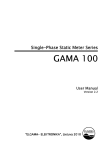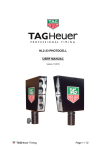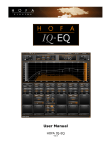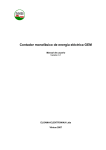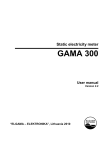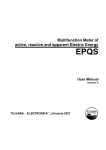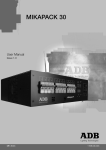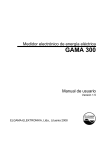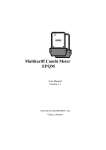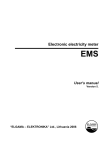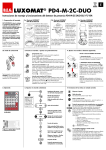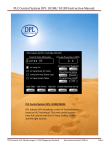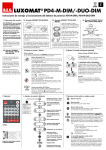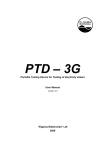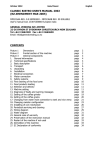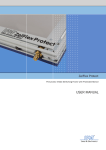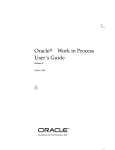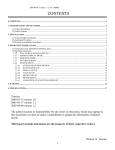Download Single-Phase Static Meter GEM - Elgama
Transcript
Single-Phase Static Meter GEM User Handbook Version 3.1 “ELGAMA- ELEKTRONIKA”, Lietuva 2004 „ELGAMA – ELEKTRONIKA” Ltd. Single-Phase Static Meter GEM User Handbook „ELGAMA – ELEKTRONIKA” Ltd. Visoriu str.2, 08300 Vilnius Lithuania Tel. +370 2 375000 Fax +370 2 375020 E-mail: [email protected] SINGLE PHASE METER GEM. USER MANUAL CONTENTS 1. DESIGNATION...........................................................................................................................8 2. MODIFICATIONS .....................................................................................................................8 3. TECHNICAL CHARACTERISTICS.......................................................................................9 4. CONSTRUCTION ....................................................................................................................10 4.1. METER CASE .........................................................................................................................10 4.2. ELECTRONIC AND OPERATION PRINCIPLE ...............................................................................11 4.2.1. Measurement module.....................................................................................................11 4.2.2. Microcontroller .............................................................................................................11 4.2.3. EEPROM memory .........................................................................................................11 4.2.4. Internal clock.................................................................................................................11 4.2.5. Liquid crystal display (LCD).........................................................................................12 4.3. COMMUNICATION INTERFACES ..............................................................................................13 4.3.1. Optical interface............................................................................................................13 4.3.2. Electrical interface ........................................................................................................13 4.4. AUXILIARY OUTPUTS .............................................................................................................13 4.4.1. Optical test output (red LED)........................................................................................13 4.4.2. Electrical Test Output S0 ..............................................................................................13 4.4.3. Relay output...................................................................................................................13 4.5. POWER SUPPLY ......................................................................................................................14 4.6. CONTROL BUTTON .................................................................................................................14 5. TARIFF MODULE ...................................................................................................................15 5.1. TARIFF PROFILE......................................................................................................................15 5.2 HOLIDAY CALENDAR ..............................................................................................................15 6. DATA SCROLL POSSIBILITIES ..........................................................................................16 6.1. MANUAL DATA SCROLLING............................................................................................16 6.2. DATA SCROLLING ..................................................................................................................17 6.3 TOTAL AND CUMULATIVE ENERGY INDICATION ......................................................................17 6.4. INDICATION OF INSTANTANEOUS POWER ................................................................................19 6.5. INDICATION OF FAILURES .......................................................................................................20 6.6. DATA READING VIA CONNECTION INTERFACES.......................................................................20 7. PREVENTION OF METER DATA........................................................................................21 7.1 MEANS OF PHYSICAL PREVENTION ..........................................................................................21 7.2 MEANS OF SOFTWARE PREVENTION ........................................................................................21 7.2.1 Password ........................................................................................................................21 7.2.2 Event register .................................................................................................................21 7.2.3 Block of communication via optical interface ................................................................21 7.2.4 Other means of prevention. ............................................................................................21 8. PREPARATION FOR WORK ................................................................................................22 8.1. ADJUSTING ............................................................................................................................22 8.2. PARAMETERIZATION ..............................................................................................................22 9. TECHNICAL SERVICE OF METER....................................................................................23 9.1. SAFETY RULES .......................................................................................................................23 5 9.2. PREVENTION AND ELIMINATION OF MALFUNCTIONS .............................................................. 23 9.2.1. Exterior inspection....................................................................................................... 23 9.2.2. Inspection of connection and parameterization constants......................................... 23 9.3 TRANSPORTATION AND STORAGE RULES ................................................................................ 24 9.4. THE PROCEDURE OF RETURNING TO MANUFACTURER ............................................................ 24 ANNEX A. ..................................................................................................................................... 25 CONNECTION DIAGRAM OF METER GEM CONNECTION TO NETWORK.............. 25 ANNEX B....................................................................................................................................... 26 METER DIMENSIONS AND POSITIONING OF FIXING HOLES .................................... 26 ANNEX C ...................................................................................................................................... 27 THE EXAMPLE OF PARAMETERIZATION DATA TABLE ............................................. 27 6 SINGLE PHASE METER GEM. USER MANUAL This User Handbook presents a description and exploitation instruction for single-phase static meter GEM. Please read this instruction prior to the use of the meter. The manufacturer does not give any guaranty in case meters are damaged during the exploitation that contravenes with the instructions and requirements of work security stated in the handbook or meter pass. The manufacturer is not responsible for the loss in case the meter is parameterized without accordance with the instructions and recommendations presented in the software description as well as with tariff order defined by the State. It does not carry the responsibility for the unprofessional acts of responsible persons in case of full or partial loss of account data. User Handbook presents the description of all possible characteristics, functions and auxiliary outputs of electricity meter. A concrete meter may not comply with all characteristics introduced in this Handbook, however, meter pass defines a precise meter configuration, possibilities and auxiliary outputs as well as a concrete connection scheme. The manufacturer has a right to change the information presented in this Handbook without the forehand warning. In addition, any copying, transmission and publication of full or partial meter documentation is forbidden without a written ELGAMA-ELEKTRONIKA permission. 7 1. Designation The electronic multi-tariff meter of direct connection is designated for accounting of active energy consumption in single-phase alternate current networks. It may also be used in automated meter reading systems for transmission of measured and calculated data into dispatching units. 2. Modifications Modifications of the meter GEM differ in accuracy class, rated voltage, maximum current, possibility to operate in one or multi -tariff mode, number of additional outputs. All GEM meters have the same case, are equipped with optical interface and electronic pulse output. All GEM xxx.xx.x type meters measure active energy consumption, display instantaneous power independently from current flow direction and indicate reverse current circuit connection. Fourtariff GEM meters register cumulative energy. Cumulative energy is total energy of all prior account periods (months), in other words, energy registered at the end of a month. Multi-tariff meters have an internal clock for tariff module control. Table 2-1 presents table of marking of modifications Table 2-1. Marking of meter GEM modifications GEM Measurement elements: One element, two – wire connection X X X. X X. X 1 Reference voltage, V 110, 120, 127 Special request 220, 230 1 2 3 Reference (maximal) current, A Direct connection, base (maximum) current 10 (100) Direct connection, base (maximum) current 10 (60) 4 5 Reference frequency, Hz 0 50 HZ 60 Hz 1 Internal clock Meter has not internal clock for tariff switching Meter has internal clock for tariff switching 0 1 Auxiliary outputs Electronic pulse output Electronic pulse output + current loop" interface Electronic pulse output + current loop" interface + relay 8 0 1 2 SINGLE PHASE METER GEM. USER MANUAL 3. Technical characteristics Table 3-1. The main technical characteristics of meter 1.0 or 2.0 (IEC 62053-21) Accuracy class 100V, 120V, 127V, 220V, 230V Rated voltage, Inom 10(60)A; 10(100)A Basic (maximum) current Inom 50 or 60 Rated frequency, Hz 0,4 Sensitivity threshold, % Inom From –250C to +55 0C Range of operational temperatures Power consumption, VA: In voltage circuit < 1 ( 0,75W) In current circuit < 0,05 2000 Meter’s constant, imp/kWh Programmable (1…4) Number of tariffs Communication interfaces: optical interface For local data reading and meter parameterization For direct data reading IEC 62056-21 300 … 2400 baud Telemetric pulses Programmable or synchronized with expire time of tariff chosen electrical interface data transmission protocol speed of data transmission S0 pulse output (IEC 62053-31) Relay output: Additional functions: registration of power outages: Influences by strong magnetic field: Uncloses of meter cover Diagnostics of internal malfunctioning Duration of data storage without power supply Dimensions, mm3 Weight, kg Service period Up to 9999 outages Total #, duration, date/time of last release Total #, duration, date/time of last close up Up to 9999 cases 20 years when T<25 0C; 2 years when T = 60 0C 230x132x59 0,95 30 years 9 4. Construction 4.1. Meter Case Meter’s case, fixing holes and terminal block meet the requirements of standards IEC 62053-21 and DIN 43857. High mechanical resistance limpid window mould of ultraviolet stabilized polycarbonate protects meter’s interior and its nameplate. Meter’s window is fixed to the background by two sealed screws. Fig. 4-1 presents meter’s exterior and composition of control elements, whereas Annex B introduces housing dimensions and composition of fixing holes. LCD Optical test output Photo sensor Optical interface Sealable screws Fig. 4-1 Meter’s exterior LCD, optical interface photo sensor and two-functional pushbutton for data scrolling are located in the front of the meter. Chapter 6 describes data scrolling commands. Nameplate of the meter contains information anticipated by IEC 62053-21 standard and list of cyclically scrolling data displayed in LED. 10 SINGLE PHASE METER GEM. USER MANUAL 4.2. Electronic and operation principle Elements of meter’s electronic scheme are under the nameplate and most of them are assembled on a single printed circuit board using surface mounted technology. The main meter components and principle of meter operation are described below. 4.2.1. Measurement module Current and voltage are measured by current transformer and resistive voltage divider correspondingly. Microcontroller conducts conversion of analogue signals into digital, data processing, display and transmission to external information collection systems. 4.2.2. Microcontroller Analogue signals of current and voltage are converted into code signals by microcontroller’s analog-code converter. Microcontroller multiplies instantaneous current and voltage values and every second calculates average power. Consumed energy (kWh) is calculated by integration of power values sequence P(t). The values calculated, in accordance with the valid tariff program, are registered in corresponding energy registers of energetically independent meter memory. ROM type memory of the controller saves the software of the meter. Microcontroller of the meter controls LCD indicator, communication interfaces, optical and electronic test outputs and relay output, provides tariff module handling, registers signals of magnetic field sensor and counts events of cover opening. 4.2.3. EEPROM memory Meter’s constants: power calibration coefficients, starting threshold and other constants entered at meter’s parameterization by manufacturer are saved in EEPROM type memory (EEPROM – electrically erasable - programmable ROM). EEPROM memory also saves accumulated data (commercial data, network events and internal failures) and meter parameters. 4.2.4. Internal clock Meter microcontroller has internal real time clock, which counts years, months, week-days, hours, minutes and seconds. Clock data is used for tariff mode operation. Internal clock stabilized by quartz resonator in multi-tariff meters is in charge of time zones switching. Clock is stabilized by quartz – crystal resonator. Software clock error compensation ensures clock error, which does not exceed 60 s per year. In case of power outages clock uses Lithium battery energy. Clock can be automatically adjusted for daylight saving changes. Variants of clock adjustment for daylight saving changes are indicated during the parameterization of meter. Table 4-1 presents all possible adjustment variants. Note: data formats of daylight saving changes are to be the same for summertime and wintertime. 11 Table 4-1. Variants of clock adjustment for daylight saving changes Date format [MMDD.hh] 0000.00 MM00.00 MM00.hh MMDD.hh Date and time of clock adjustment No adjustment for daylight saving changes Clock is adjusted for summer time on the last Sunday of a month MM at 2 a.m. by winding the clock 1 hour forward; Clock is adjusted for standard time on the last Sunday of a certain month MM at 3 a.m. by winding the clock 1 hour backward; Clock is adjusted for summer time on the last Sunday of a specified month on the time specified by winding the clock 1 hour forward; Clock is adjusted for standard time on the last Sunday of a specified month on the time specified by winding the clock 1 hour backward; Clock is adjusted for summer time on the time and date specified by winding the clock 1 hour forward; Clock is adjusted for standard time on the time and date specified by winding the clock 1 hour backward; 4.2.5. Liquid crystal display (LCD) GEM meter is equipped with digital Liquid crystal indicator, which has 84 controllable segments. Liquid crystal indicator displays all data and parameterization constants, accumulated in a meter. Fig. 4-2 presents the composition of controlled segments in the indicator and their designation, and Section 6 describes detailed schemes for information presentation on LCD indicator. Indicator feeding scheme guarantees its operation in temperature range from – 20 °C to +65 °C. Communication indicator Value Meter error Low battery voltage Measurement units Tariff of Indication Indicators of active tariff Load indicator * 8 symbols are used for the display of measurement units Fig. 4-2. Designation of LCD indicator’s segments After turning network voltage off, microcontroller operates in energy saving mode, and LCD is switched off. However, if photo sensor is affected by light pulses or button is pushed, microcontroller turns on the LCD, scrolls cycle data 3 times and turns off LCD. 12 SINGLE PHASE METER GEM. USER MANUAL 4.3. Communication interfaces All GEM meters have optical communication interface. GEM XXX.XX.1 and GEM XXX.XX.2 meters have as well electric communication interface – 20mA “current loop”. 4.3.1. Optical interface Optical interface is used for data downloading into mobile PC and for meter parameterization via OKK optical head. Data transmitting protocol via this interface complies with the requirements of IEC 62056-21 Standard. This interface is also used for meter’s calibration in the factory. GEM meters maintain the interface block function, which is active via optical communication interface. This function protects unauthorized meter parameterization. Read more about this function in Chapter 7.2.3. 4.3.2. Electrical interface Electrical interface is designated for automatic data transmission to outside equipment. GEM type meters have two-wired ‘20 mA current loop’ type electrical interface fed by outside device. The maximum supply voltage of open circuit is <30V, maximum loop current is <30 mA. In case of reverse connection interface is not active, it is save from damage. IEC 62056-21 protocol is used for interface via “current loop”. 4.4. Auxiliary Outputs 4.4.1. Optical test output (red LED) There is a red light diode in the meter’s nameplate, which produces light impulses with frequency proportional to measured consumed energy. Only the producer is able to program meter’s constant (2000 imp/kWh) and impulse duration (30 ms). 4.4.2. Electrical Test Output S0 Meter has electrical test output for transmission of electric pulses carrying information about energy consumption. There is an n-p-n transistor with an open collector in test output, which is galvanically separated from meter’s circuit by optocopler. Constant of impulses and their duration is the same as for optical test output. Maximum voltage applied to test output is 24 V, maximal current is 100 mA. 4.4.3. Relay output Relay output can switch current of 120 mA and voltage up to 250 V. Relay control can be programmed in two ways: • Normally open contacts are connected for indicated valid tariff time zone; • Normally open contacts are connected for two time intervals programmed (discreteness of determination 15 min.). 13 4.5. Power supply GEM meters contain pulse power supply. It guarantees the functioning of meter when the voltage is in the range of 100-280 V. When voltage is disconnected, meter’s microcontroller, supplied by lithium battery, switches to energy saving mode. In this case, only internal meter’s clock uses the energy. When network voltage is turned on power of lithium battery is not used. A lithium battery in normal environmental conditions can support microcontroller’s energy saving mode for not less than 10 years with network voltage off and temperature range from –25 to +55 °C. 4.6. Control button Meter has bifunctional control button (see Fig.4-3) mounted on the front meter part. In position A, command button is used to display specific information in LCD indicator. The button provides the following commands: • • short signal (push and hold button for <0,5s); long signal (push and hold button for >2s). Control button and photo-sensor provide identical signals. For detailed information about data display in LCD and readout sequences see Chapter 6. The position B of the control button is used for communication unblock. Not sealable position Sealable position Fig. 4-3. Mechanical control button . Change of button function In order to change button function it is recommended to use a screwdriver. In order to unlock the communication via optical interface, turn the button 90° according to the clock hand (the seal is to be eliminated prior to unlock). Read more about communication lock function in Chapter 7.2.3. Button sealing Button sealing may be performed only in position A (see Fig. 4-3A). In addition, diameter of sealing wire is to be 2 mm. 1mm diameter wire should be used in twofold manner. Sealing wire is to be stretched tightly. 14 SINGLE PHASE METER GEM. USER MANUAL 5. Tariff module Tariff module of meter may be active in one-tariff and multi-tariff mode. Up to four tariffs can be used when multi-tariff mode is activated. Programmed tariff module performes data distribution among the registers, whereas tariff control is performed by internal microcontroller clock. 5.1. Tariff profile GEM meter has a tariff module, controlled by tariff profile, which defines the order, control and time of day, week and year tariffs. Flexible structure of the tariff module allows adapting almost every tariff program without additional modifications. Tariff module consists of three separate programs. 1. Day profile. Day profile is a profile, which activates selected tariff in selected time interval. Up to eight time intervals can be set for each day profile and only one tariff must be assigned to each interval. Each time interval is described by time of interval beginning. Tariff module of GEM meter allows creating up to 15 day profiles. 2. Week profile. Week profile is a profile, which activates profiles of a day according to sequence indicated during meter parameterization. The same day profile is assigned for all off-days. Each week profile is described by eight numbers. Each of these numbers show, which day profile must be activated in a certain day. Eighth number shows number of day profile, which is activated during holidays. Up to 10 week profiles can be set in GEM meter. 3. Season profile. When a new season of tariffs begins a specified week profile is activated. The profile describes up to 12 tariff seasons. Tariff meter module is able to control one season profile. Season profile indicates season activation date (month and day) and week profile assigned to the season. 5.2 Holiday calendar Tariff module has register for fixed holidays. Each holiday, entered in this register is described by day profile, which is in position 8 in active week profile. Days are entered into the register and deleted from it during the parameterization of meter. 15 6. Data scroll possibilities Meter GEM has the following possibilities to display data on the LCD: • To scroll data and parameterization constants manually; • To scroll data automatically; 6.1. Manual data scrolling There are two ways to control data output on LCD manually: • With control button (position A); • By affecting photo sensor with light signals. There are two commands user can generate with both control button or photo sensor: • Short (<0,5s) signal – indicator can display new data by light signals or by short mechanical button push; • Long (> 2s) signal – indicator can display detailed review of meter parameter by light signals or by mechanical button push. Manual data scroll mode is activated by long signal. LCD windows block diagram and their search scheme is given in Fig. 6-1 In this scheme, continuous pointer indicates short signal and dotted pointer indicates long light signal. The first column of Fig. 6-1 shows ‘windows’ of the main LCD menu; scrolling sequence can be formed of them during meter parameterization. The picture explains designation of windows. The second column of Fig. 6-1 depicts the main widows of meter’s programmed constants. The windows of this column differ from other columns in having identification indexes 1…8 separated by mark ‘P’ on the left side of parameters’ value field. Meter’s configuration set during the session of parameterization is encoded in the window marked by Index 1. Table 6-1 illustrates the designation of every sign, whereas Table 6-2 gives possible meanings of the signs. Table 6-1. Explanation of meter configuration code Code Sign designation Format of date Number of tariffs Digits after point Meaning 0 1 1…4 0 1…3 0 Function of relay contacts 1…4 Configuration Year_month-day [YY_MM-DD] Weekday_month-day [WD_MM-DD] Number defined Only whole numbers Defined number of numerals 2 time intervals programmed for 24 hours cycle Synchronized with tariff defined Windows marked by Indexes 1,3 … 6 give accesses to the windows of lower level menu and their reading scheme is shown in the 3rd column of Fig. 3. All the windows of the 3rd column on the left 16 SINGLE PHASE METER GEM. USER MANUAL side of the field have identification indexes made of two or three numerals separated by dots. Information presented in windows is identified with the help of column of indexes given in Table 6-2. Windows of the second column marked by Indexes 7 and 8 in Fig. 6-1 indicate the dates of daylight saving changes. 6.2. Data scrolling LCD indicator turns into data scrolling mode if photo sensor is not affected by light impulses for a minute. The first column of Fig. 3 presents sequence of maximal length parameters in scrolling mode. Only parameters chosen during meter parameterization are shown. Every parameter in the cycle is shown for 8 seconds. When network voltage is disconnected only the influence of long light signal pointed to photo sensor may display the data. In this case, total energies of each tariff are being displayed for three times repeatedly, and then the indicator becomes inactive. Table 6-2. Index meanings stated in LCD indicator Index 1.0 1.1 1.2 1.3 3.1…3.C Title Start of first relay activity time interval. Format hh: mm End of first relay activity time interval. Format hh: mm Start of second relay activity time interval. Format hh: mm End of second relay activity time interval. Format hh: mm Tariff season description. Format MM.DD.WP. MM.DD – date of season beginning; WP – profile of week, activated during tariff season validity 4.0…. 4.A Description of week profile. Each day profile is described by two screens: first 4.X YYYY, which corresponds to the days of Mon-Thu, second 4.X_ YYYY, which refer to the days of Fri-Sun and holiday. 5.0…5.E List of day profiles. Format: day PX_. X – number of day profile. 5.X.0 – Description of day profile. 5.X.0 – 5.X.7 – beginnings of new intervals; 5.X.8 and 5.X.9 5.X.9 shows tariffs, which are active during certain time interval. One tariff is assigned to one interval. X – number of day profile 6.1…6.C Description of holidays. Format 6.X YY, where X – number of a month, YY – quantity of holidays in a certain month 6.X.0 – Description of holidays. Format 6.X.Y ZZ, where X – number of a month; Y – 6.X.Y running number of holiday in a month. ZZ – day in a month, which is described as a holiday 6.3 Total and cumulative energy indication Four-tariff GEM meter registers total energy in each tariff zone, total energy in all tariff zones and cumulative energy in each tariff zone by the end of each month. These data can be displayed on LCD. LCD displays the value, which is chosen during the parameterization of the meter. LCD shows the value after total energies of each tariff. When LCD displays total energy of all tariffs, indicator of data tariff shows “0”, whereas blinking sign of displaying data tariff zone is showed when LCD displays cumulative energies. 17 Time [hh:mm:ss] Index of parameter Date format Number of tariffs Digits after decimal point Relay mode LCD test Serial number T1 energy T4 energy Total energy or cumulative energy Power End of cycle Fig. 6-1. Scheme of data review 18 SINGLE PHASE METER GEM. USER MANUAL Table 6-3. Data read via communication port and its OBIS codes Index Format Commentary 0.0.0 XXXXXXXX Meter’s serial number 0.9.1 hh:mm:ss Time 0.9.2 YY-MM-DD Date F.F XX Fatal error, if XX=80 C.5 XXXXXXXXXX Meter’s status string: 1.8.1*0 00000000.000 Total energy in register T1 1.8.2*0 00000000.000 Total energy in register T2 1.8.3*0 00000000.000 Total energy in register T3 1.8.4*0 00000000.000 Total energy in register T4 1.8.1*1 00000000.000 Cumulative energy in register T1 1.8.2*1 00000000.000 Cumulative energy in register T2 1.8.3*1 00000000.000 Cumulative energy in register T3 1.8.4*1 00000000.000 Cumulative energy in register T4 C.2.1 YY-MM-DD,hh:nn:ss Date and time of the last parameterization C.7.0 0000 Number of voltage breaks C.7.1 YY-MM-DD,hh:nn:ss Date and time of the last voltage break C.7.2 YY-MM-DD,hh:nn:ss Date and time of the last voltage recovery Request parameter: Additional service information: Y = 3 - Number of case openings, total duration of openings, date and time of last case close-up Y = 3 - Internal errors; Y = 3 - 10 last network disconnections/connections date and time; Y = 3 - Duration and number of strong magnetic field influences YXXXXXXXXX Relay status 1/0 (turned on/turned out) XYXXXXXXXX Summer time 0/1/2 (absent/summertime/wintertime) XXYXXXXXXX active tariff 0/1…4 XXXYXXXXXX active tariff season. Y – 1 … Bh XXXXYXXXXX active week profile. Y – 1 … Ah XXXXXYXXXX active day profile. Y –0 … Eh XXXXXXYXXX battery status 0/1 (good/change) XXXXXXXYXX internal errors 0/1 (absent/present) XXXXXXXXYX current direction 0/1 (normal/reverse) XXXXXXXXXY load indication 0/1 (absent/present) 6.4. Indication of instantaneous power Indication of instantaneous power may be included into sequence of data scrolled or chosen by affecting optic sensor with light pulses. This window shows the average power integrated during the last 8 seconds. Power is calculated and indicated by step of 0.009 kW. 19 6.5. Indication of failures If a fatal error occurs which leads to the corruption of account data an inscription ‘Er’ appears on the right side of LCD. When lithium battery voltage falls down to critical limit, a flashing symbol appears on the right side of LCD. Information on network disturbances, influences by strong magnetic field and case openings are not shown on LCD though communication interfaces may determine them. 6.6. Data reading via connection interfaces Meter consumer may use ELGAMA-ELEKTRONIKA Ltd. software “Gempard” or “Gemdat” for data reading via optical interface, its processing and graphical image. Two-wire electric interface is used for remote data reading. Electric communication interfaces enable data transmission via physical two-wire lines in local network. In order to transmit data in large distances, GSM, inter-modem or AD interface. “User’s manual” of each software describes data reading procedure. Table 4 presents the data viewed via interfaces and its OBIS codes. 20 SINGLE PHASE METER GEM. USER MANUAL 7. Prevention of meter data Meter and its software possess a prevention function against illegal data elimination, constant, date and time of clock change. 7.1 Means of physical prevention Meter covers are sealed with screws in order to prevent covers from opening. Both, a seal of manufacturer and a seal of Metrology center are used. In addition, organization seal, which implements a meter, is put on the clamp block screw. 7.2 Means of software prevention 7.2.1 Password Password can protect meter parameters from illegal actions. Password cannot be longer than the sequence of 8 ASCII symbols. A system of prevention from password guess is implemented too. If the meter registers more than four cases of trying to parameterize the meter by using the wrong password, optical communication interface is blocked for 24 hours. During this time the meter does not accept even the right password. 7.2.2 Event register Event register is a memory part of a meter which stores data about events. GEM meter registers the following events: Power outages. The total number as well as dates and time of 10 last outages. Date and time of last parameterization. Internal errors of meter. Codes of damage is registered. Influence by magnetic field. The total number of influences, total influence duration and date and time of last influence is registered. Openings of meter cover. The total number of openings, total openings duration and date and time of last cover close-up is registered. (this possibility is ordered additionally). 7.2.3 Parameterization lock Meter provides lock feature for optical communication interface. This feature prevents meter from unauthorized meter parameterization. Feature is disabled by pressing control button in position B (seal must be eliminated prior). When feature is disabling, a communication indicator is signaling on LCD for a while. Parameterization unlock lasts for 1 hour. 7.2.4 Other means of prevention. Meters calculate only progressive energy independently from the direction of current circuit connection. However, in the case of reverse connection LCD shows a warning signal – load indicator starts to blink. 21 8. Preparation for work 8.1. Adjusting Meter adjusting is made during its manufacture process and, if necessary, after its repair. In the process of adjusting, current phase and null signal shifts are compensated, current and voltage transmission coefficients are assigned. In this way, a required meter precision is achieved. Adjusting coefficients are entered and recorded via optical interface from personal computer into EEPROM. This function can be completed only by opening the sealed meter’s window. Adjusting requires special software, standards of alternating current and alternating voltage, and therefore, only manufacturer or its authorized representative can perform adjusting. 8.2. Parameterization During parameterization parameters are set in the meter memory via optical communication interface. Prior to meter parameterization communication block is to be disconnected. Configuration constants are entered into EEPROM via optical interface during meter’s parameterization. There can be two groups of parameters entered: • Manufacturer parameterization; • Customer parameterization; Manufacturer parameterization is possible only after opening meter’s window by special software. This parameterization enables to enter such data as: serial number, code of modifications, constant, duration of output pulses, etc., i.e. parameters remaining unchanged as long as meter is in action. Customer parameterization supposes entering the constants adopting meter to the requirements of energy supplier. Those constants refer to: number of tariff time zones, the first tariff time zone validity limits, number of digits after point, relay output parameters, current date and time, parameters displayed in scrolling mode. These parameters are transmitted using “ELGAMAELEKTRONIKA” Ltd. software “Gempard” from PC via optical head OKK. Annex C presents example of manufactory parameterization. In the process of parameterization internal meter’s clock is set automatically – the date and time of personal computer are entered into a meter, and therefore, it is important to set exact time in computer before this operation. ‘User’s Guide’ and the ‘Help’ of windows of the software present the instructions on meter’s parameterization and work with the software. 22 SINGLE PHASE METER GEM. USER MANUAL 9. Technical service of meter 9.1. Safety rules 1. The safety rules of electric equipment maintenance should be followed while installing and using a meter. 2. Installing, uninstalling, parameterization and verification can be performed only by authorized organizations, which have technicians with necessary qualifications. Meter assembling works can be fulfilled only by persons who have not lower than medium electric safety group. 3. Meter’s connection or disconnection from network should be done when voltage in the network is turned off. A protection from accidental network voltage connection must be established. 4. No accessories can be hung on a meter, it is forbidden to hit or strike meter’s case. 9.2. Prevention and elimination of malfunctions If suspected that meter works improperly, the following actions should be performed: 9.2.1. Exterior inspection Before starting voltage supply to the meter make sure its case has no mechanical damages, there are no signs of overheating, all wires are properly connected. NOTES: Do not plug a meter into network if it is mechanically damaged. This can cause staff injuries and destroy meter as well as other equipment! Before switching on network voltage, it is necessary to check if jumper closes both little bolts in terminal block above lead-in clamps. 9.2.2. Inspection of connection and parameterization constants After plugging a meter into electric network check whether date and time are correct, whether meter shows right energy direction, valid tariff time zone, calendar and tariff seasons. 1. If meter shows wrong date and time, contact a representative from the organization in charge of the meter installation. 2. If LCD indicator shows a warning note ‘Er’, the meter should be uninstalled and passed for repair works. 3. If energy direction is wrong, check if inputs are connected properly to terminal block. 4. If meter calendar season, season time name or valid tariff time zone does not correspond to real situation, meter’s parameterization data has to be checked and errors has to be corrected by repeated meter’s parameterization. 23 9.3 Transportation and storage rules Prior to the usage meter is to be kept in a closed room, where the temperature ranges from 5°C to 40°C and average area humidity is up to 80% when temperature being 25°C, in a transportation packing. The room must be without harmful gas or steam. Packed meters are put in the shelves not more than five rows on each other and not nearer than 0.5 m from heating devices. Unpacked meters can be kept only in repair workshop. Meter can be loaded not more than five rows on each other and separators must be used. The temperature must range from 10°C to 35°C, average area humidity must not exceed 80% when temperature being 25°C. During wintertime meters must be kept in a heated room for 6 hours or more. Meters are to be transported only in closed vehicles (carriage, container, hold). Shake acceleration is to be up to 30m/s², 80-120 strikes per minute. The temperature must range from -50°C to +50°C, average area humidity must not exceed 98% when temperature being 35°C. 9.4. The procedure of returning to manufacturer In case malfunctions cannot be eliminated on the spot, the meter should be returned to the manufacturer for repair or replacement. Meters on their return to enterprise must have their Pass with notices of organization in charge of their exploitation and short description of meter’s malfunctioning. Manufacturer: „ELGAMA – ELEKTRONIKA” Ltd. Visorių str. 2, LT-08300, Vilnius Lithuania Tel.: +370 5 2375 000 Fax: +370 5 2375020 E-mail: [email protected] 24 SINGLE PHASE METER GEM. USER MANUAL Annex A. Connection diagram of Meter GEM connection to network Figure A-1 presents the general scheme of GEM meter connection when the meter has all auxiliary outputs. However, a concrete variant may contain differences in regard with this figure. Therefore, the user must read about the meter connection in meter pass (the scheme may also be presented on the meter cover) and must follow these instructions! 3 4 6 + - + - L CS X N Figure A-1. General GEM wiring diagram Table A-1 describes the designation of auxiliary contacts. NOTE. The scheme of concrete meter may contain differences in regard with the scheme introduced in Fig. A-1. Precise meter connection scheme is presented in meter pass, on the meter cover or on the cover of clamp block. Designation of auxiliary outputs: Pin No. Contact designation 23 Current loop “+” 24 Current loop “-” 35,36 Relay output 40 S0 output “-“ 41 S0 output “+” 25 Annex B. Meter dimensions and positioning of fixing holes 26 SINGLE PHASE METER GEM. USER MANUAL Annex C The example of parameterization data table Meter parameters Tariff number for energy: Digits after decimal point: Daylight saving changes Summer time: Winter time: Relay output function: T0 intervalai paroje T01: T02: 1, 2, 3, 4 0, 1, 2, 3 WD_ММ - DD, Date version: YY – ММ - DD Cumulative, Data, displaying in cycle after T1…T4 TΣ [MM-DD hh:mm] 03-00, 00 10-00, 00 T0 T1 T2 T3 T4 [hh:mm-hh:mm] 00:00 – 00:00 00:00 – 00:00 LCD cycle Date Time LCD test Holidays (8-th day in tariff table) Month Day Month January April February May March June Serial Nr Day Т1 ... Т2 Month July August September Cumulative Day Power Month October November December Day Tariff seasons and numbers of assigned week profiles Nr. Date 1 2 3 01.01 00.00 00.00 Week profiles Nr Monday 1 0 Week profile 1 0 0 Nr. Date 4 5 6 00.00 00.00 00.00 Week profile 0 0 0 Tuesday 0 Wednesday Thursday 0 0 2 23:00 Т2 00:00 Т0 3 00:00 Т0 00:00 Т0 Nr. Date 7 8 9 00.00 00.00 00.00 Friday 0 Week profile 0 0 0 Nr. Date 10 11 12 00.00 00.00 00.00 Saturday 1 Sunday 1 Week profile 0 0 0 Holiday 1 Day profiles № 0 1 1 07:00 Т1 00:00 T2 Tariff switch-over 4 5 00:00 Т0 00:00 Т0 00:00 Т0 00:00 Т0 27 6 00:00 Т0 00:00 Т0 7 00:00 Т0 00:00 Т0 8 00:00 Т0 00:00 Т0



























